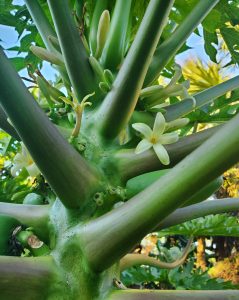
A papaya is not a true tree, but a tree-like or arborescent plant. This large herbaceous plant is relatively short-lived but can be a great producer of high-quality fruit. I have grown them for years with successes and failures along the way. However, the attempt to grow this exotic and much-favored fruit is part of the fun of gardening, and when you do get useable fruit, the reward is spectacular!
Papaya originated in Central America but is now grown worldwide in tropical regions. It is a major crop in some areas, even Florida has a small commercial industry. However, the backyard papaya is a worthy and obtainable goal. You can start papaya from seed, or simply buy a named started plant. Plants from seeds will end up either female, male or bisexual. This must be taken into consideration when starting papayas from seed as sufficient plants will be needed until you are sure of the plant type you have. Your best situation is to have a self-pollinating type (bisexual) . A female only plant will of course need a male plant nearby to allow cross-pollination to occur. If all goes well, a one-foot plant started from seed will develop flowers in about four months. A good papaya plant can produce up to eighty pounds of fruit in a year.
Papayas need full sun sites in well-drained soil for best results. They cannot tolerate flooding, so make sure that the planting site is high and dry. Proper fertilization with regular small amounts of nutrients will ensure that the plant grows steadily. Use any of the granular fertilizers suitable for tropical fruit and apply as per label instructions. Young plants should be fed every two weeks with no more than a quarter of a pound of fertilizer – increase this slightly as the plant grows, and as per label directions. Once the papaya is about seven months old, fertilizing once a month is sufficient. While papaya do not like standing water, they will need to be irrigated regularly to support good growth. Mulch will help retain moisture and suppress weeds. Apply mulch so that it is about twelve inches away from the trunk.
Perhaps one of the most easily prevented insect pests is the papaya fruit fly. This fly lays eggs in the fruit which grow into maggots ruining the fruit – nasty! A simple paper bag placed over the newly developed fruit will serve as a mechanical barrier to keep female fruit flies from inserting eggs. Paint strainer cloth can also be used as a barrier. Other than papaya fruit flies, my worst problems have been the occasional freeze and high winds. Unless your papaya is in a microclimate or an otherwise warm protected area, temperatures down to thirty-one degrees F can cause damage. Papayas will often recover from a light frost in time, but a hard freeze can take a plant out of commission. High winds are no friend of papayas either. When papayas are heavily laden with fruit, they can easily topple over in high winds.
Of all the varieties I have tried, ‘Red Lady’ has given me the most success. It is self-pollinating and is commonly available at nurseries. Papaya fruit is ready to harvest when between one-tenth and one-third of the peel color has changed to yellow. However, for the best flavor, leave the fruit on as long as possible. Store at room temperature until fully ripe. The ripe fruit will be in good condition for about seven days. If you have fallen green fruit or need to rescue some before a freeze, it can be used like a vegetable. I have had it before, and it reminds me of squash which takes on the flavor of whatever it is cooked with.
With some planning and upkeep, you can grow your own papaya and maybe even share one with a neighbor. A plant-ripened papaya from your own backyard is a delicious treat unlike anything else! For more information on all types of tropical and sub-tropical fruit to grow in our area, or to ask a question, you can also call the Master Gardener Volunteer Helpdesk on Mondays, Wednesdays, and Fridays from 1 to 4 pm at 764-4340 for gardening help and insight into their role as an Extension volunteer. Ralph E. Mitchell is the Director/Horticulture Agent for UF/IFAS Extension Charlotte County. He can be reached at 941-764-4344 or ralph.mitchell@charlottecountyfl.gov. Connect with us on social media. Like us on Facebook @CharlotteCountyExtension and follow us on Instagram @ifascharco.
Resources:
Crane, J. H. (2019) Papaya Growing in the Florida Home Landscape. The University of Florida Extension Service, IFAS.
Morton, J. 1987. Papaya. p. 336–346. In: Fruits of warm climates. Julia F. Morton, Miami, FL. https://www.hort.purdue.edu/newcrop/morton/papaya_ars.html
 1
1
